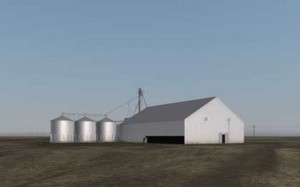
John Gerrard, Oil Stick Work, (Angelo Martinez / Richfield, Kansas), 2008, Realtime 3. © the artist and Art on the Underground. Production: Werner Poetzelberger. Modelling: Daniel Fellsner. Programming: Helmut Bressler. Additional programming: Matthias Strohmaier. Model: Angelo Martinez
Canary Wharf underground station offers the best and the worst opportunity an artist could hope for.
“There are 45 million people who will travel through that station per annum, which is extraordinary. There’s no gallery in the world which could even boast a fraction of that kind of potential audience,” says John Gerrard.
“But of course, it’s not a receptive audience. It’s a hurrying, blind audience in a way.”
Gerrard is responsible for a vast projection on the far wall of atrium, which requires nothing if not patience. The computer generated simulation unfolds in real time, day by day, with a narrative scheduled to last for 30 years.
Oil Stick Work (Angelo Martinez/Richfield, Kansas) is set in a Kansas landscape dominated by a grain silo. Dawn breaks about noon British Summer Time and the scene fades to darkness at around 2am.
Between those times, a lone figure sets to work painting the building black. He paints one square metre each day with an artist’s crayon. By the time he completes his task, in 2038, US oil supplies are projected to run dry.
Art on the Underground will be showing the astonishing time based work for 12 months, and Gerrard hopes that in that time a “fraction” of the audience will notice the work’s progression.
The tempo of his art is a far cry from the pace of nearby life. The Jubilee Line station serves some of the world’s busiest banks. “I think the banking context is a very good foil for the work, for the slow build of the work,” says the Irish artist.
He also expresses amazement at the latest forms of (high frequency and algorithmic) trading. “It’s almost become quite anarchic what’s happening in those environments,” he says.
“You’ve got people basically spending billions to gain in microseconds on somebody else in terms of speculation.”
The central theme in Oil Stick Work, intensive farming, is clearly not unrelated. In the 1930s, oil-powered agriculture caused catastrophe when the prairies succumbed to the worst dust storms ever seen in America.
Today the same landscapes are dominated by ominous and anonymous buildings such as the grain silo above or the grow finish units used to farm and slaughter pigs. People are few and far between, but with one notable exception.
Angelo Martinez is the name of a New York builder who auditioned as a stand-in for a worker who told Gerrard to stop taking photos of one of the installations in Kansas. Now with virtually remodelled features, the artist says it “really is a portrait of him.”
The unreal localities which inspired Oil Stick Work are well suited to 3D simulations. “I’m slightly on my own with the medium which is curious,” notes the artist.
“There is an established arena of game art which is in existence, but this particular kind of static approach, which I think has a lot of potential, I don’t think there’s anybody working like this at the moment.”
That medium, according to Gerrard, “was effectively born in a military context,” and for his next work his is taking the form back to its roots.
“The new work I’m doing at the moment is actually remaking a historical scene which is from the Iran-Iraq war, the first Iraq war from the 1980s, and in it there is a soldier figure…who is enacting a kind of impossible performance.”
This will be the first time the artist has used military training technology to recreate a military training exercise. “I’ll see how that goes. I mean, it’s a bit of a risk,” he says.
But despite the outward calm of a piece like Oil Stick Work, organised aggression is already very much a theme.
“Those grow finish units on the American landscape are in and of themselves a type of horror story of gargantuan proportions,” he suggests. “I don’t think there are many games that would reach that level of…what is it? You know, the implicit violence in those scenes.”
From Kansas to Canary Wharf, what you cannot see is what can shock the most.
Written for Culture24.


















